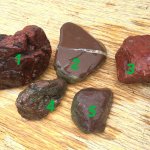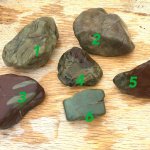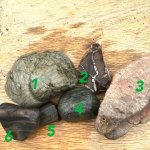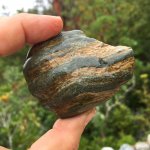bonafideslacker
Greenie
- May 20, 2018
- 13
- 21
- Detector(s) used
- A pair of Garrett Ace 300s that I've no idea how to use properly yet, and pinpointer.
- Primary Interest:
- All Treasure Hunting
Hi everyone,
I'm in coastal southern Oregon and my family has taken up rockhounding as a hobby since there are such abundant sources for pretty stones in the creeks, rivers, and beaches here.
By way of being the one who's most interested by far in the research department, I've spent hours every week for the past couple months researching local geology as well as general knowledge on words like 'sedimentary' and 'igneous'. I have rubbed elbows with folks here and elsewhere who use words like 'breccia', which I've nearly figured out how to pronounce properly...
..but I still can't even begin to classify or identify most of these damn rocks. (Ha~ It's so eternally frustrating)
So I'm going to bore you other members here with seriously newbie stuff, like "Will someone please take the time to identify each stone in the photos I've included, by whatever is it's most commonly known name?" (The internet must have christened every stone at least a dozen times, because there seems to be no solid consensus whatsoever for many things.) They're all very simple stones, nothing eye-popping, but I'm still darned if I'm going to let a bunch of petrified wood stump me. (heh)
Which leads me to: how is it possible to identify petrified wood without looking at it microscopically? I've uploaded a photo with some obvious petrified wood pieces in it, but when using google images to search 'petrified wood', many of the images pulled up look nothing whatsoever like wood. So how's a girl to know?
The attached photo with 'red' stones are all things which are identified as 'red jasper' during google image searches. Is it reasonable that all these shades and shapes are jasper, or are they something else entirely?
The greenish shiny/smooth looking stones have shown up as everything from 'chert' to 'oregon jade' to 'petrified wood' to 'chalcedony'....what is the difference and how can I tell?
The single stone in the photo is just cool, oddly banded, and looks like nothing else we've found. I stand zero chance of identifying it myself, so..?
Thanks so much for your patience and help,
Dana
PS. Will experience bear a lot of this out for me or does one need a degree (or advanced study) in geology to be able to know minerals and gemstones on sight?




I'm in coastal southern Oregon and my family has taken up rockhounding as a hobby since there are such abundant sources for pretty stones in the creeks, rivers, and beaches here.
By way of being the one who's most interested by far in the research department, I've spent hours every week for the past couple months researching local geology as well as general knowledge on words like 'sedimentary' and 'igneous'. I have rubbed elbows with folks here and elsewhere who use words like 'breccia', which I've nearly figured out how to pronounce properly...
..but I still can't even begin to classify or identify most of these damn rocks. (Ha~ It's so eternally frustrating)
So I'm going to bore you other members here with seriously newbie stuff, like "Will someone please take the time to identify each stone in the photos I've included, by whatever is it's most commonly known name?" (The internet must have christened every stone at least a dozen times, because there seems to be no solid consensus whatsoever for many things.) They're all very simple stones, nothing eye-popping, but I'm still darned if I'm going to let a bunch of petrified wood stump me. (heh)
Which leads me to: how is it possible to identify petrified wood without looking at it microscopically? I've uploaded a photo with some obvious petrified wood pieces in it, but when using google images to search 'petrified wood', many of the images pulled up look nothing whatsoever like wood. So how's a girl to know?
The attached photo with 'red' stones are all things which are identified as 'red jasper' during google image searches. Is it reasonable that all these shades and shapes are jasper, or are they something else entirely?
The greenish shiny/smooth looking stones have shown up as everything from 'chert' to 'oregon jade' to 'petrified wood' to 'chalcedony'....what is the difference and how can I tell?
The single stone in the photo is just cool, oddly banded, and looks like nothing else we've found. I stand zero chance of identifying it myself, so..?
Thanks so much for your patience and help,
Dana
PS. Will experience bear a lot of this out for me or does one need a degree (or advanced study) in geology to be able to know minerals and gemstones on sight?








